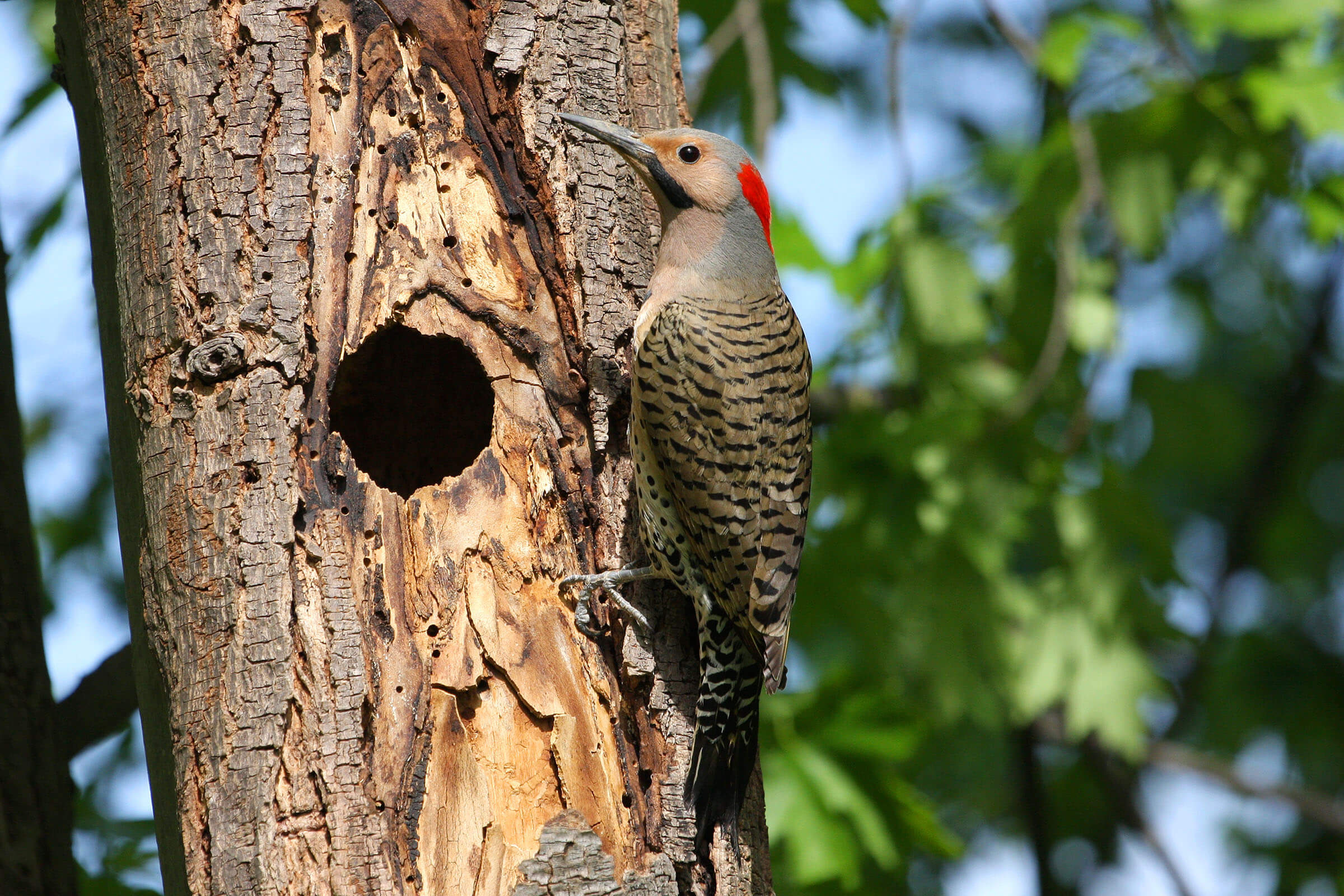Woodpeckers, flickers, and sapsuckers are all birds that are members of the Picidae family. They have short sharp-pointed beaks with long tongues, stiff tail feathers, sharp claws, and short legs. Many species will nest in human-made structures and have extended their habitat to include utility poles, buildings, and houses. Woodpeckers are generally considered beneficial birds because of the large number of insect pests they eat.
Can I lethally remove a woodpecker that is damaging my property?
Woodpeckers are classified as nongame migratory birds and are federally protected under the Migratory Bird Treaty Act of 1918 and Nevada state law. Before any person may take (pursue, hunt, shoot, wound, kill, trap, capture), possess, or transport any migratory bird, including its feathers, eggs, or nest, they must secure permits issued by the U.S. Fish and Wildlife Service and NDOW. No federal or state permits are required to scare or harass protected migratory birds that are destroying property unless the species is threatened or endangered.
If extreme damage has occurred to private property and all non-lethal control methods have been exhausted, it may be necessary to remove the offending woodpecker. In such instances, permits may be issued by the US Fish and Wildlife Service and NDOW. Generally, there must be a good case to justify the issuance of a permit.
Application for a permit must include a recommendation from US Department of Agriculture-APHIS-Animal Damage Control personnel. You should begin by contacting Wildlife Services in Reno (775-851-4848), Elko (775-738-3341) or Ely (775-289-2791).
What do I do if a woodpecker is damaging my property?
Woodpeckers do not pose a threat to humans or their pets, however, in urban settings they can damage wood and stucco-sided houses and other structures. In most areas, if damage does occur, it usually occurs between February and June, which corresponds with the breeding season when birds are establishing territories. In southern Nevada, overwintering birds, like northern flickers, cause problems in the fall and winter as well as springtime. They may also peck holes in siding in search of insect larvae. Drumming (term used to describe the sound of rapid pecking) on metal or wood, including gutters, drainpipes, TV antennas, plumbing vents, and wooden siding, poles, or hollow trees causes little damage other than possible paint damage.
Woodpeckers can be prevented from accessing the side of a house and potentially damaging wood and stucco siding beneath the eaves by creating a barrier. Attach a sheet, tarp, or plastic netting (1/4 inch mesh or less) from the outside edge of the eave and angle it back to the wood siding. A larger area of siding can be protected by vertically hanging the sheet, tarp, or bird netting from the roof gutter. Any ledges or cracks the bird might use as a foothold while drumming should be covered as well. Metal (aluminum) sheathing can also be placed over the pecked area to provide permanent protection. Take care to observe for multiple holes indicating insect searching versus one large hole that may indicate a nesting cavity.
Woodpeckers are not easily driven away from an area once they have established a territory so deterring them as soon as a problem is identified is important. Repeatedly scaring the bird away with sudden loud noises, such as hand clapping or banging pans from a window may be effective. A squirt of water from a garden hose may have a similar effect. Sticky or tacky bird repellents, such as Roost-No-more, and Tanglefoot, can also be smeared on and near damaged areas including tree trunks and limbs to repel woodpeckers and prevent further damage. Some species, like northern flickers, will occasionally use artificial nest boxes. Some success has been achieved by placing nest boxes on the building in the vicinity of the damaged area (to discourage nesting on the actual building). If you have dead trees in your yard, consider leaving them in place. Cutting down dead and decaying trees deprives woodpeckers of nesting, drumming, and food sites, and may force them to take a look at your house.
Consider examining your house for the presence of an insect infestation if you observe a woodpecker habitually feeding on a wood-sided portion of your home.
What if I find a sick or injured woodpecker?
Sometimes woodpeckers get sick or get injured. Collisions with cars, power lines, and windows are not uncommon. If you see a woodpecker that appears to be injured, observe its behavior for a few minutes, and note the exact location. If the bird is in the same location after 24 hours, please contact NDOW. NDOW staff can help determine if the bird is injured. Please do not attempt to feed or provide water to an injured woodpecker, this can make things worse.
Resource: Woodpeckers: Damage Prevention and Control Methods – PDF

